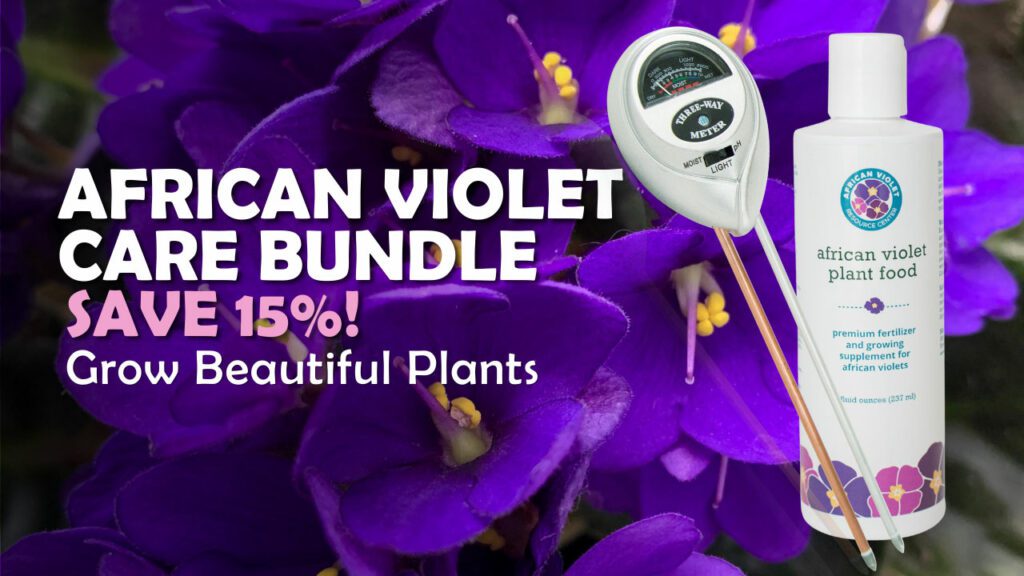With its vibrant and distinctive flowers, African Violets are a popular choice among indoor plant enthusiasts. But if you’ve recently wondered, “Why are my African Violet leaves turning light green?” you’re not alone. This issue is a common problem that many gardeners face, and luckily, there are easy solutions to help your plants thrive once again.
Environmental Causes
Excessive Sunlight
Healthy African Violet leaves should have a deep, rich green color resulting from the intense level of chlorophyll production inside the plant cells. But too much light can disrupt the photosynthesis process and cause the leaves to turn light green and, in some cases, bleach them out completely white.
Additionally, excessive direct light can cause plant sunburn, manifesting as yellowing or whitening of the leaves. Because the dark green of the leaves is a result of a high concentration of chloroplasts and pigment, when they lose some or all their pigments, the leaf takes on a lighter green color.
These causes aren’t mutually exclusive, nor do they work in a vacuum, meaning that your plant may exhibit several of these symptoms at once.
How To Fix Excess Sunlight Discoloration of African Violets
In both excessive sunlight situations, the simplest solution is to move your African Violet to a shadier location or use a sheer curtain or shade cloth to filter the light. It could take several weeks or months for the new leaves to show the desired dark green color. But once they do, you can remove any remaining discolored leaves.
If brown leaf tips or edges accompany the light green color, your plant is sunburnt, and more than just moving it to a new spot is required to fix the issue. Because sunburnt leaves won’t turn back to their original color, you will need to prune them off. Pruning can be done using clean scissors and cutting the leaves at the base of their stem.
Temperature & Humidity Issues
The ideal temperature range for African Violets is between 65 to 80 degrees Fahrenheit. Too cold, the plant’s enzyme production is inhibited, causing leaves to turn yellow and light green. On the other hand, if it’s too hot, chlorophyll production is disrupted, resulting in lighter-colored leaves.
Humidity levels, depending on the species, should be kept between 40 to 60%. If it drops too low, the plant will not have enough moisture to produce new chlorophyll and maintain its rich green color. Too high, and you risk mold growth that can cause discoloration and rot.
How To Fix Temperature & Humidity Issues
Temperature control can be easily achieved by moving the plant away from drafts or heaters. If your home is too hot, consider investing in a fan to circulate air and cool down the room. To increase humidity levels, you can cluster plants together or place them on top of a tray filled with water and pebbles. An alternative option is using a humidifier to maintain consistent humidity levels.
If mold or rot has already set in, you must remove the affected areas and increase air circulation around the plant. You should also use Leaf Shine wipes to clean off any remaining mold spores and add an extra layer of protection.
Soil Quality
African Violets prefer a porous, well-draining soil that allows air to reach the roots. If your plant is potted in compacted or poorly draining soil, it can cause root rot and nutrient deficiencies, leading to light green leaves, among other plant health issues.
Additionally, the overall maintenance of soil health is a critical factor in the long-term health of your Violets. Over time, the nutrient levels deplete and can cause deficiencies that affect leaf color.
How To Fix Soil Quality Issues
You won’t have to worry much about overall soil quality if you start by using premium indoor potting soil from the start. Look for one that is slightly acidic, rich in micronutrients, and contains green waste that helps facilitate nutrient imbalances. It also helps if it has perlite or peat moss, as these ingredients reduce the risk of soil compaction, ensuring your plant’s roots receive enough oxygen.
If you haven’t started with a good-quality potting mix, you can repot your plant with a better-quality mix, making sure to remove any compacted soil around the roots gently. When repotting, look out for any signs of root rot and trim off any affected roots. Once potted in a new soil mix, your plant should start showing signs of recovery within a few weeks with vibrant, dark green leaf growth.

Nutrient Deficiencies
Lack of Calcium
Calcium is vital to plant growth and is essential in producing strong cell walls, promoting healthy root growth, and maintaining vibrant leaf color. A calcium deficiency can cause leaf curling, stunted growth, and light green or yellow foliage.
You can tell if a calcium deficiency is the answer to “Why are my African Violet leaves turning light green?” if you notice the discoloration happening in the margins along the leaflet.
The best solution to increase calcium levels in African Violets is through a balanced plant food fertilizer that contains calcium. Another option is to add crushed eggshells to the soil, which will slowly release calcium as they break down.
Lack Of Copper
Photosynthesis and enzyme metabolization wouldn’t be possible for the African Violet without copper. A deficiency in this nutrient can cause yellowish, light green leaves, stunted growth, and other issues affecting the base of the stem or leaves. You may also notice the plant’s edges turning brown.
There are many ways to get more copper into the soil, but the easiest is with a multivitamin that contains copper. You may also want to use a root supplement that increases the plant’s capacity for absorption and nutrient uptake – two key factors that facilitate optimal photosynthesis and leaf health.
Lack of Boron
Primarily responsible for optimal flower growth, boron also helps transport the main nutrients to all key parts of your African Violet. It’s a common deficiency in Violets, and if you notice that your plants aren’t blooming, it’s got a more bush or brittle appearance, and there is lighting on the leaves, then you’re dealing with a boron deficiency.
Using a potting mix that is rich in boron is the best solution, but you can also use a multivitamin or plant food fertilizer that contains this nutrient. Be aware that while boron is essential for the health of African Violets, too much of it can have the opposite effect, so make sure to follow proper dosage instructions.
Lack of Magnesium
To avoid chlorosis, which causes yellow hues in the leaves, your African Violet needs magnesium. Magnesium is essential for chlorophyll production and helps maintain a rich green leaf color.
Signs that a magnesium deficiency is to blame for your African Violet’s light green leaves include a yellow or fading color that starts at the base of the leaf and moves outwards. Often, this affects older leaves rather than younger ones. You may also notice a more bush and brittle appearance on affected plant parts.
Organic compost is a great DIY solution to magnesium deficiencies in African Violets, but in case you don’t have access to any, you can use a fertilizer rich in magnesium. Plant fertilizers should be mixed into the topsoil every 4 to 6 weeks, but follow the package instructions carefully to avoid over-fertilizing.
Lack of Manganese
In most houseplants, manganese is the nutrient responsible for promoting healthy root growth. It is also essential in photosynthesis and helps produce chlorophyll, contributing to vibrant leaf color.
When your African Violet lacks manganese, it may show signs of a general decline in the veins and upper part of the stem. There may also be brown spots depending on the severity of the deficiency.
Manganese is a micronutrient, so formulas or indoor potting soil rich in micronutrients should solve this issue. Ferrous sulfate and chelated iron can also provide a quick boost of manganese to your African Violet.
Lack of Nitrogen
Without nitrogen, your African Violet will experience stunted growth, with weak stems and small, pale green leaves. Nitrogen is a significant component in chlorophyll production and is necessary for plant health.
If leaves start dropping off in addition to the pale hue, lack of nitrogen is probably to blame. You may also notice older leaves showing signs of yellowing.
Online African Violet communities are full of DIY solutions to increase nitrogen levels in African Violets. Some popular options include using used coffee grounds, but the best is usually a plant fertilizer used in combination with a high-quality indoor potting mix containing a balanced NPK ratio.
Natural Causes
Spent Leaves
The ornamental beauty of the African Violet offers a year-round display of purple, pink, and white. But all plants, no matter their species, have a finite life. Chances are that if you ask yourself, “Why are my African Violet leaves turning light green?,” it may simply be because the old leaves have reached the end of their life cycle.
Older leaves often turn a lighter shade or yellow before they fall off. This is entirely normal and shouldn’t be a cause for concern. However, you can prune off spent leaves to encourage new growth and keep your plant looking fresh.
How To Keep African Violet Leaves Healthy
Maintaining optimal environmental and nutrient conditions will ensure that your African Violet leaves stay a vibrant, dark green, but it shouldn’t be a one-time effort. Here are some tips to keep your African Violet leaves healthy and green:
- Use a plant probiotic. Like humans, plants are full of bacteria that can help promote plant health and nutrient absorption. The best plant probiotic will also stimulate root growth and microbe production, both essential for healthy leaf color.
- Incorporate smart gravel. Smart gravel is a great way to improve drainage, and African Violets love it. It promotes good airflow in the soil, prevents waterlogging, and enables healthy root health – all of which are essential for strong, healthy leaf growth.
- Invest in a moisture meter. Soggy soil causes root rot, and that, in turn, leads to light green leaves. A moisture meter measures soil wetness levels, enabling you to water less or more often as needed for optimal plant health.
You can purchase these items separately or as part of a comprehensive African Violet Plant Care Bundle. Purchasing in a bundle ensures that you have all the essentials for healthy African Violet leaf care at your disposal and will never miss out on the chance to beautify your home with these easy-to-grow plants.
FAQ: African Violet Plant Care
1. Why are my African Violet leaves turning light green in the winter?
African Violets can become dormant during the winter months, causing a decrease in overall growth and leaf color. Make sure to adjust your watering schedule accordingly and provide adequate lighting for optimal photosynthesis.
2. Where should I put my African Violet indoors?
African Violets prefer bright, indirect light, so placing them near a window is ideal. Avoid direct sunlight as it can cause leaf scorching. You can also consider hanging them in the kitchen or bathroom, as the steam from cooking or showering can provide a humid environment that African Violets love.
3. Should I rotate my African Violet?
Yes, rotating your African Violet every week or each time you water will ensure that all sides of the plant receive equal light exposure, promoting healthy growth and leaf color.
Keep Your African Violet Looking Beautiful
African Violet leaves turning light green is a common problem that can be easily solved with proper nutrient balance and care techniques. With a few adjustments to your plant care routine, you can enjoy vibrant, dark green leaves and beautiful blooms all year round.
At the African Violet Resource Center, we know how much joy these ornamental houseplants can bring and are dedicated to providing tips, tricks, and resources for African Violet enthusiasts. For more information on African Violet care, subscribe to our newsletter for exclusive content and updates on new products in our shop.
More Great African Violet Resources
African Violet Fertilizer – How to Grow a Healthy Plant
Everything You Need to Know About African Violet Leaves







